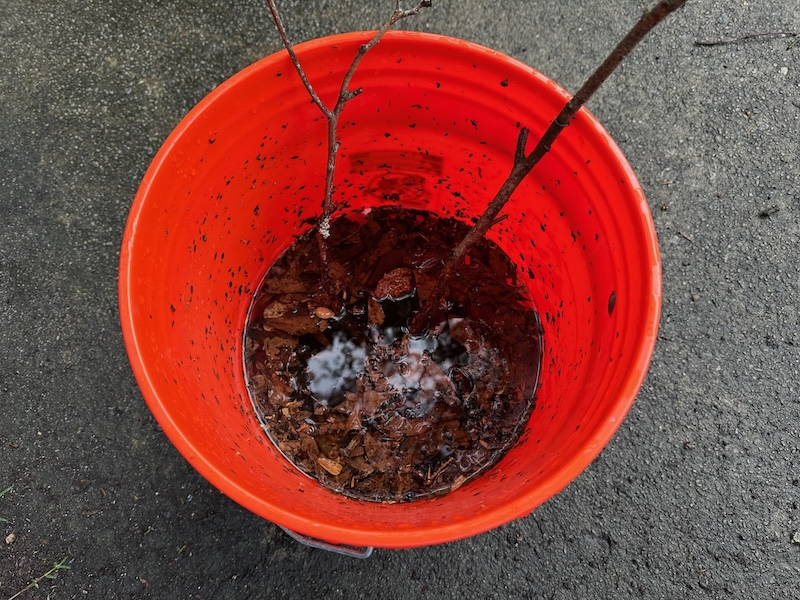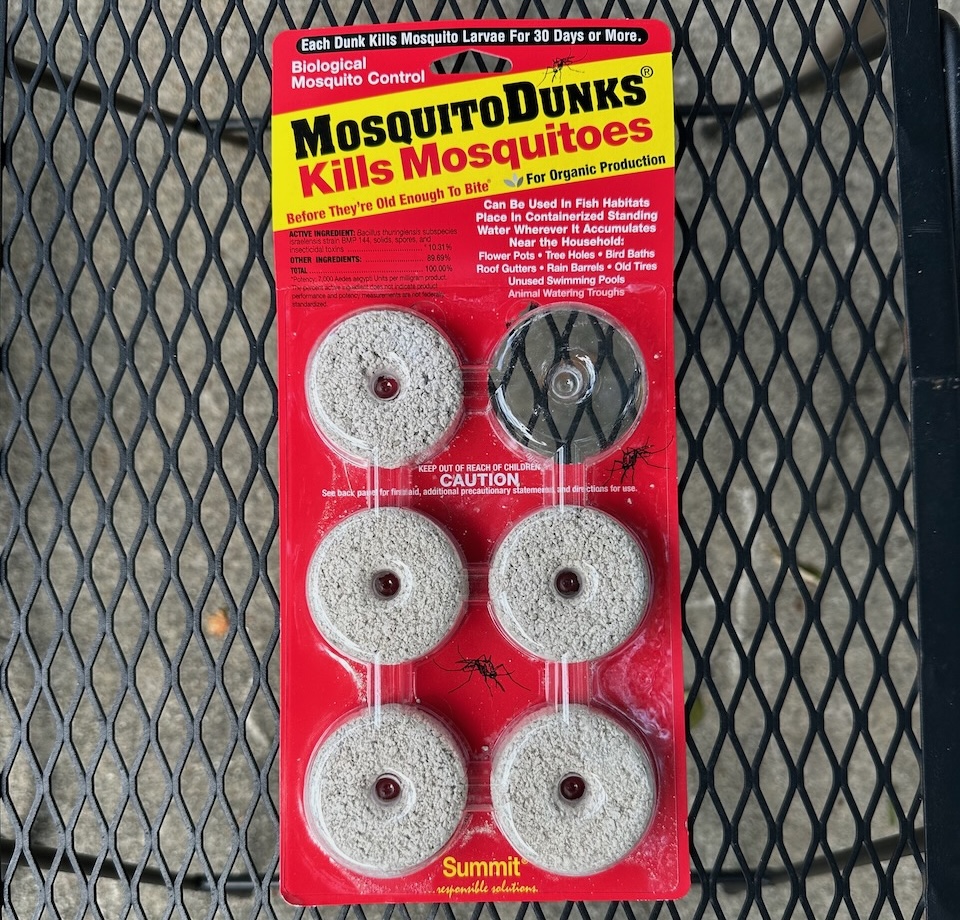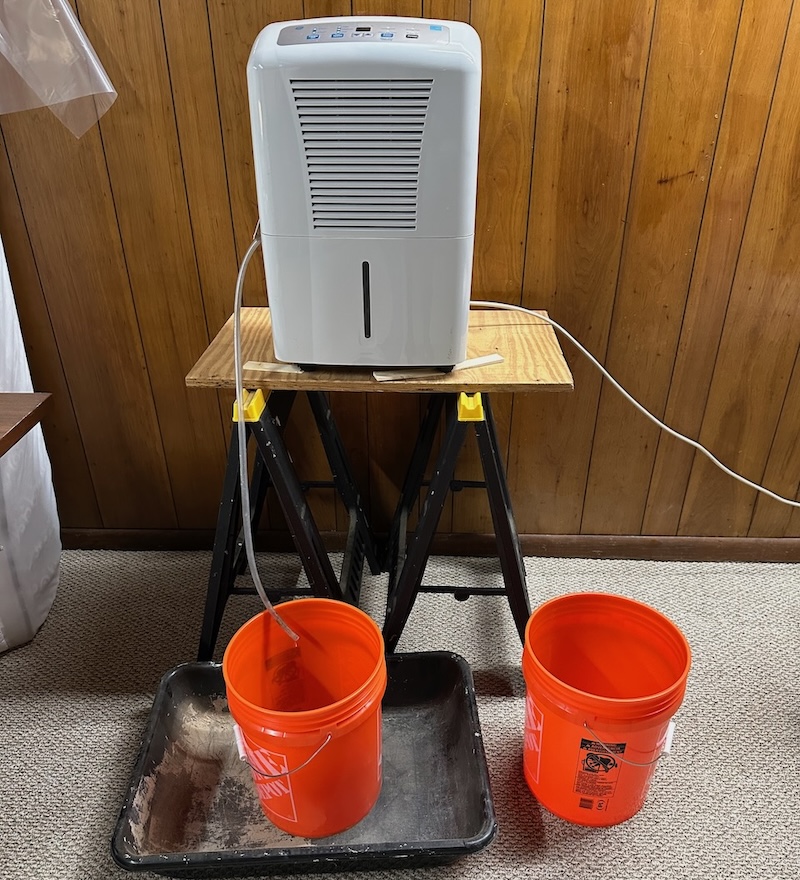I usually focus on the building science of homes, HVAC, and indoor environmental quality. Today, though, I’m going to cover a topic of outdoor environmental quality. I’ve had mosquitoes in my backyard since we bought the house in 2019. This year, however, the yard is practically uninhabitable all the time because the constant rainfall has kept the yard wet and overpopulated with mosquitoes. That’s about to change because last week, I heard about the perfect solution: the Mosquito Bucket of Death.†
So, for the past few days I’ve been setting them up and putting them out in my yard. I’ve got four out there now and may add more. I wish I had started them in April because it takes a while for them to do their thing. And their thing is using an otherwise harmless bacterium to kill the mosquito larvae after the female mosquitoes lay their eggs in the bucket. Here’s a video showing a bit about how they work and how to set them up.
There’s a lot of info online about the Mosquito Bucket of Death, and I’ve looked at a bunch of it. Here’s what I’ve distilled from those sites to help you make your make your own.
Prepare the Bucket of Death
Most of the websites say to use a 5 gallon bucket.* Some say 3 to 5 gallons. But the concept works even in small containers. The main difference is that the small containers probably need more upkeep to maintain the water level and more buckets to reduce the mosquito population. The process is the same, though, no matter what size bucket you use.

To begin, you fill the bucket about half full of water. Then you add a handful or two of decaying leaves, soil, compost, or old grass clippings.
Next, put a couple of sticks in there. Those are for two things. First, good bugs that fall in will have an escape path. Second, I’ve read that mosquitoes like something to land on near the surface of the water before they lay their eggs.
If you want to keep squirrels, chipmunks, and other small critters from getting trapped in the bucket, you also could put a piece of hardware cloth or chicken wire over the top of the bucket. To keep it in place, you can use zip ties.
Once you’ve got that set up, let it sit outdoors for a couple of days. Most of the sites I found say that’s for fermentation, although I doubt it’s true fermentation that happens. But I’m a big fan of fermentation, so I’ll go with the flow here.
Add MosquitoDunks®
Once you’ve got the buckets doing their thing in your yard, you should see some mosquito activity around them. I’ve noticed a bunch of them in and around my death buckets the past few days. After two or three days, drop in the material loaded with the mosquito larvicide bacterium. They’re called MosquitoDunks®,* and you can find them at hardware and home improvement stores or through this Amazon affiliate link.*

The dunks contain an unhealthy—for the mosquito larvae—dose of the bacterium, Bacillus thuringiensis, or BT. Don’t worry about your dog, Moonpie, or your cat, French Fry. They can drink straight from the bucket and be perfectly fine. Hey, it’s probably better than when they drink from your toilet, right?
Anyway, here’s what a lot of the posts about the Mosquito Bucket of Death get wrong, though. You don’t need a whole dunk in each bucket. If you read the instructions, you’ll see that a quarter of a dunk is more than enough for a 5 gallon bucket. Each dose you put in is supposed to last about 30 days, so it’s a pretty inexpensive mosquito control method.
The building science connection
Another thing folks say is to let the water sit for a couple of days before you start adding organic matter and dunks if you’re using chlorinated tap water. That’s because you want as much of the chlorine as possible to evaporate from the water to make it more appealing to mosquitoes.

I have a ready source of non-chlorinated water at my house. My basement has very little cooling load, especially since I remodeled the walk-out side. So I’ve been running a dehumidifier down there. I can get half a bucketful overnight, so it’s easy for me to start my Mosquito Buckets of Doom with fresh water.
How long does it take?
The life cycle of a mosquito includes four stages: egg, larva, pupa, adult. They start as an egg in a raft of eggs in stagnant water. After a few days, the mosquito bucket of death has aged and become fetid enough for the female mosquitoes. They then lay their eggs, with each female laying 100 to 200 eggs in her short lifetime.
After another few days, the eggs then hatch into mosquito larvae. You may have seen them as slender little linear creatures that hang out near the surface. Because of their motion, they’re often called wigglers. They’ll be in the larval stage from four or five days to two weeks.
And that’s the part of their life cycle we’re most interested in. As the little wigglers begin their journey to adulthood, they eat the organic matter they find. That includes particles from the MosquitoDunks you add to the bucket. Some time after ingesting the BT, they die. Which means they never become adult mosquitoes, preying on your unprotected skin.
The mosquito larvae started showing up in my death buckets on day five. Now that they’re eating, they’re starting to die. Meanwhile, the current adult population of mosquitoes in my yard will continue until they die. Males, which don’t bite people, live about a week. Females, which need a blood meal to develop their eggs, can live up to six weeks.
The answer to the question, then, is that if your Mosquito Bucket of Death is really effective, you should see a reduction in the mosquito population in about a month.
For your outdoor enjoyment, your wallet, and the planet
The Mosquito Bucket of Death is a far better way to reduce your mosquito problem than hiring a pest control company to come in a spray your yard. According to Forbes, spraying for mosquitoes costs from $75 to $400 per visit. Worse, it’s not that effective. I’ve read that having a company spray your yard kills only about 10 percent of the adult mosquitoes.
Worst of all, though, is that spraying insecticides indiscriminately comes with a lot of collateral damage. It also kills butterflies, bees, lightning bugs, and other insects that are good for your yard. Here’s a thorough article on the safety of mosquito sprays.
The path to a yard with a lot fewer mosquitoes is clear. Avoid the expense, ineffectiveness, and collateral damage of chemical sprays. Set up your Mosquito Buckets of Death and start enjoying your yard again in a few weeks.
If you have mosquitoes in your yard, you should be heading to the store to buy buckets and MosquitoDunks right now. Also check out the resources below for more information.
Allison A. Bailes III, PhD is a speaker, writer, building science consultant, and the founder of Energy Vanguard in Decatur, Georgia. He has a doctorate in physics and is the author of a bestselling book on building science. He also writes the Energy Vanguard Blog. For more updates, you can follow Allison on LinkedIn and subscribe to Energy Vanguard’s weekly newsletter and YouTube channel.
† These things also are called the Mosquito Bucket of Doom. I learned about them at the Atlanta BS & Beer meeting, where Tres Crow of GreenBox Homes mentioned them in his presentation on sustainable landscapes.
* This is an Amazon Associate link. You pay the same price you would pay normally, but Energy Vanguard may make a small commission if you buy after using the link.
External Resources
Wikipedia page on the mosquito
Try the ‘bucket of doom’ to eliminate mosquitoes without harmful pesticides
Effects of mosquito sprays on humans, pets, and wildlife
Tips for killing and repelling mosquitoes
BTi for Mosquito Control, US EPA
Related Articles
Building Science Begins in the Yard
Rain Barrels, Chickens, and Walking the Sustainable Living Talk
Lloyd Alter Is Living the 1.5 Degree Lifestyle
Comments are welcome and moderated. Your comment will appear below after approval. To control spam, we close comments after one year.
